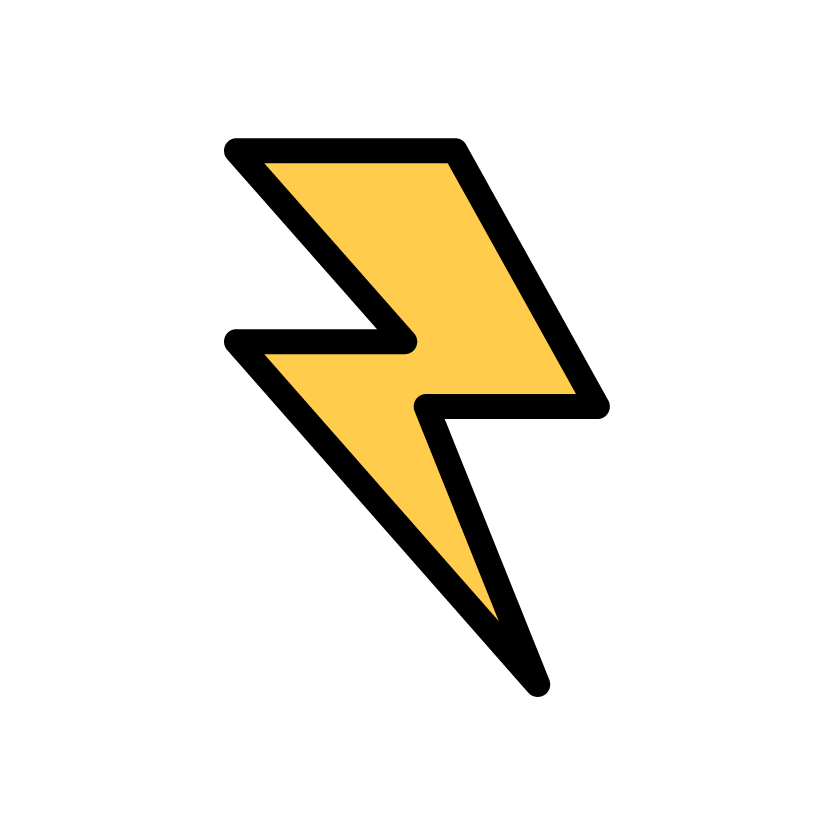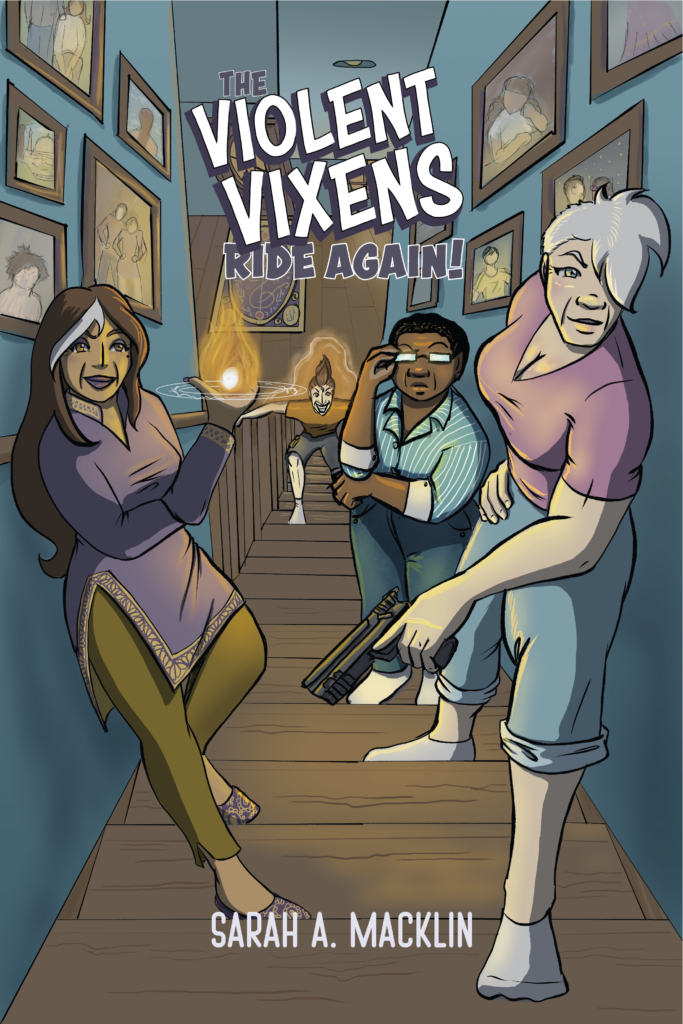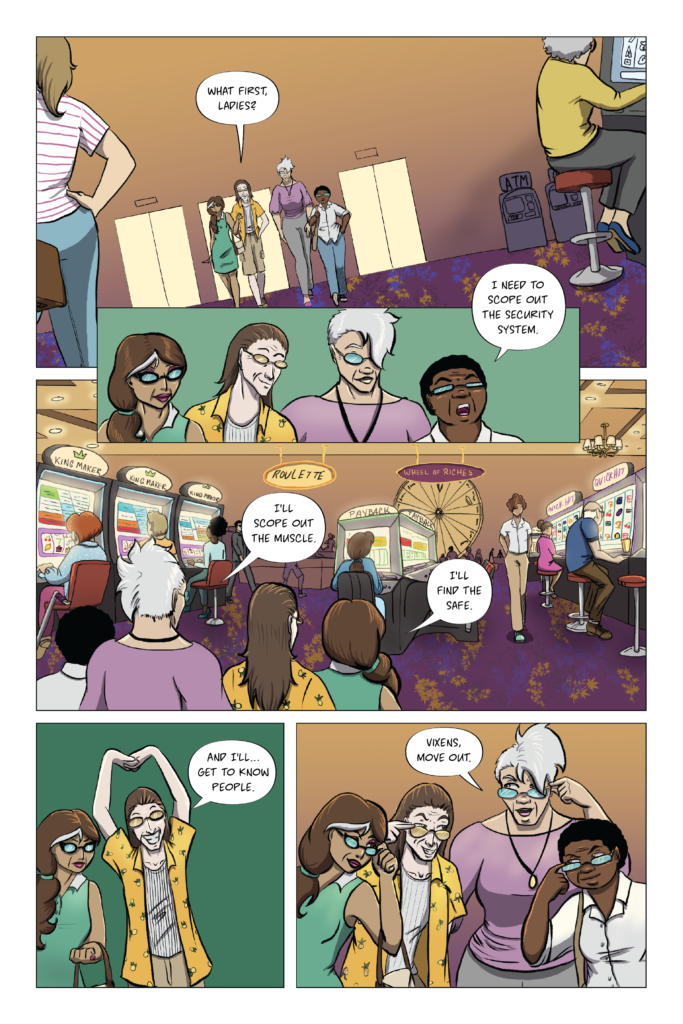Last updated on October 10, 2024
by S.E. Fleenor

It’s a heist! It’s a team up! It’s supervillains! No, The Violent Vixens Ride Again by Sarah A. Macklin is all of the above–and more! This riotous and nostalgic graphic novel delves into the lives of characters who are decidedly under-explored in superhero stories: women who are supervillains over 40. When one of the women gets out of prison, she gets the rest on board to pull one last job…and old dynamics are unearthed.
Macklin takes us into the world of her story and the coolest villains around in this interview. The Violent Vixens Ride Again can be purchased at Macklin’s kofi shop.

The Violent Vixens Ride Again is, as the title suggests, a team reuniting for one final job. However, this is the first (only?) graphic novel in the series. Why did you decide to start with a group with so much history? What do we get from a story about old friends reuniting that we don’t from a fresh team up?
I absolutely love heist stories where “we have to get the gang back together.” The relationships are already baked in and can help or sabotage the goal the characters have. They already know each other’s strengths and weaknesses but also each other’s soft spots which is so much fun to play with.
Your story revolves around a group of friends who are not often the leads of superhero stories and particularly not team up stories, though there are notable exceptions. Your team are all women, all supervillains, and all over 40. Why did you want to tell this particular story and what do you think the field of superhero comics misses out on without these kinds of characters?
I think this story was born out of the fact that I turned 40 in 2019 and realized I need to think about how the rest of my life is going to look. As I looked at my favorite entertainment, comics included, I realized that there weren’t too many older heroes and far less older villains. I’ve found one group of older women villains and they were such a joke that I was insulted. So the Violent Vixens were born, a group of older women who chose a life of villainy and aren’t ashamed of it.
Comics needs more capable older people. One doesn’t turn 40 and suddenly become a wizened elder in a rocker, especially women who are still relegated to matron positions once they reach that age. If older women are shown for the full, complete people they are, maybe we can continue to change society’s perception of them in real life.
In that same vein, in your afterword, you say “life doesn’t end at 40 and neither does villainy.” So often I think villainy is a matter of perspective. One has to wonder who’s eviler: the people who steal from powerful people with ill-gotten gains or the powerful people who stole the money in the first place? Undeniably, your characters break the law. And while they do so for various reasons–though it seems the main one is because they can and they’re sick of holding back–the metanarrative of breaking laws that protect the most powerful feels timely. What does your graphic novel tell us about villainy?
People are complicated. My ladies are villains, yes. They rob and shoot people, but they also try their best not to kill anyone. (Mostly because murder charges carry serious jail time.) The ones who have family love them dearly. Volt/Madison has her cat which is her world. Hysteria/Pamela has the Vixens and they’re her family. People that society has deemed a villain are people and should be portrayed as such. In my opinion, we have to show that people can make bad choices. Sometimes, it’s for good reasons. Sometimes, it’s for selfish or horrid ones. But we can’t make villains seem like someone different from the rest of us, like an “other,” because that keeps us from seeing the villains that are closer than we think.
Also in your afterword, you discuss how you had to learn all the aspects of making comics from lettering to layouts and everything in between. We’d love to hear more about the process of teaching yourself, if there were any surprise aspects you enjoyed, and if learning the whole spectrum of skills changed how you create comics now or will in the future.
I’ve been trying to make comics in fits and starts since I was a teenager in the before times. Like layout paper, pencil, and inks before times. I didn’t actually complete a project until a couple of years ago. But for Violent Vixens I decided to sit down and work. I read The Essential Guide to Comic Book Lettering and relearned Adobe Illustrator. I found out that I really, really like lettering. Part of me wants to be a letterer too now. On the other hand, learning how to layout a comic for print was a skill that I’m still learning to love.
Making this graphic novel from start to finish helped me refine my process since I quickly learned the steps I liked and disliked. I plan out my panels with the dialogue in mind now where before I would just jump into drawing and figure it out later. My inking and coloring has gotten SO much better. The best part of all is that I can actually see how my skill has grown.
Two of the Vixens used to date and there is a very sexy and cool photo of them on a motorcycle together in a couple panels. That part of their past doesn’t come up a lot but once you realize it’s there, it kind of seeps into every moment between the two. A lot of queers stay friends with their exes and it feels distinctly different than most cishetero folks’ experiences. I’m curious what you think that dynamic brings to your story and why you made space for that in a graphic novel with surprisingly little backstory.
Hysteria and Mystery dating back in the day was an aspect that was there almost from the start. It felt natural. Their friendship is what brought them together and that should be the most enduring aspect of their relationship. Their dynamic helped me show how much the Vixens have been through together and how much they’ve been a part of each other’s lives. These four women have been friends for decades. They are SO close. And their love for each other is undying. Not even a breakup can change that.

Your art is so expressive and bold and you use every panel, large or small, carefully to build a rich world around your characters. You also cleverly use inset panels to show us the dynamics between the characters that are already there but that they aren’t addressing directly in panel. It brings so many emotional layers to the story. I’d love to hear how you developed your style and what your wildest dreams are for your art.
I am a child of nineties anime. There were constantly quick shots to get another character’s reaction or moments where characters were literally butting into another character’s shot. That kind of comedic back and forth felt natural for the Vixens’ story. I also wanted this story to be a little bit over the top so their expressions and actions needed to reflect that. My “serious” comics are very straight forward in the character acting so I guess it’s a change that happens organically when I switch to comedy.
On a philosophical level, I’m curious about why you think we need superhero, or in this case supervillain, stories? What do these familiar tropes, stories, and dynamics do for us? And what happens when a graphic novel like The Violent Vixens Ride Again starts flipping some tropes while embracing others? In other words, with all the stories about capes out there, why do fresh perspectives, particularly from creators who have historically been excluded from superhero comics, still draw us in?
It’s always fun to imagine oneself larger than life with powers that could alleviate your real-life problems even if it’s just boredom. And villain stories are a way we can throw off societal restrictions to indulge in getting our way just a little bit.
I loved that in Violent Vixens I could play with all the super tropes I enjoy while letting people who wouldn’t normally be allowed in the playground have fun. The muscular girl rarely gets the man so, damn it, she would. The Vixens are an all-woman team with only one white person in a genre that’s still very white and male. My character Hysteria is not close to what is considered conventionally attractive but dated the most beautiful team member. My ladies are all of an age where women in comics disappear unless they’re a matron in someone else’s story. When cis white hetero male characters aren’t the focus of 98% of the comics, we get deeper stories, richer stories that reflect the lives of so many marginalized peoples. And after all that we go through in our daily lives, don’t we deserve to see ourselves as super?
You also work on the webcomic Parenthood Activate with friend of the pod Stephanie Williams. I’d love to hear more about the experience of collaborating with Steph and anything you learned from that experience that you carry into your work now.
First of all, Steph is an incredible writer. Secondly, if it wasn’t for Parenthood Activate, I wouldn’t have gotten back into making comics seriously. It gave me a much-needed boost when I’d pretty much given up on my childhood dream.
It was so natural to come in as the artist. My kids were teens when we started but every script was something I could relate to as another parent. It made the comic personal for me and I tried to put that into my work then. Now, especially as I make my own webcomic, Villainous, I hope I can make moments where my readers are like, “Yeah, I’ve been there.”
If readers want to learn more about you and your comic work, where can they find you online?
People can check out my art on my website, sarahamacklin.com. I can also be found on Blusky and Used-to-be-Twitter as @killianfantasy and I’m on Instagram as @sarahmacklin.

Sarah A. Macklin was born and raised in Blythewood, South Carolina, a little town that you’ll miss if you blink. She’s loved comic books since her mother bought her a Spiderman digest comic in Winn Dixie in the 80’s. That love of art brought her to study art at Winthrop University, majoring in graphic design and then illustration.
She is the artist for the webcomic Parenthood Activate! (written by Stephanie Williams) and the graphic novel, The Violent Vixens Ride Again. She’s also the creator of the webcomic, Villainous.
When not making comics you can find her busy at her keyboard writing her latest speculative fiction piece.
S.E. Fleenor is a writer and editor who wears many hats. They are a freelance developmental editor, editor of Decoded Pride literary magazine, co-founder of QueerSpec.com, and their essays, creative nonfiction, and fiction appear in various publications including The Independent, Buzzfeed Reader, VICE, Electric Literature, Xtra Magazine, them.us, Upworthy, Denver VOICE, and many more. They teach online and in-person writing workshops, and co-host the comics and pop culture podcast Bitches on Comics, which has over 65,000 downloads, putting us in the top 15% of all podcasts. They are a head writer and voice actor for the horror narrative fiction podcast Tales of the Sapphire Bay Hotel, and their short story “Anomalous” was adapted to audio through Decoded Horror Channel’s Graveyard Orbit. They are a member of GALECA: the society of LGBTQ entertainment critics
